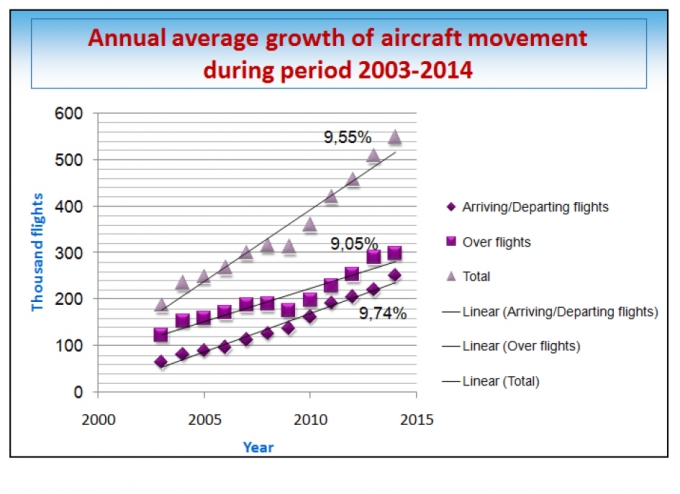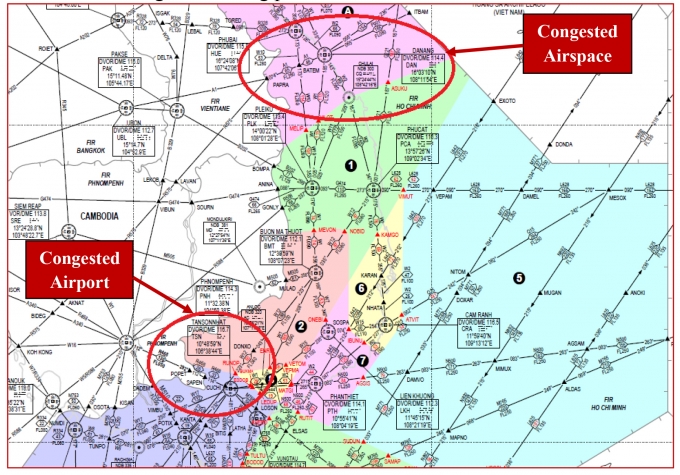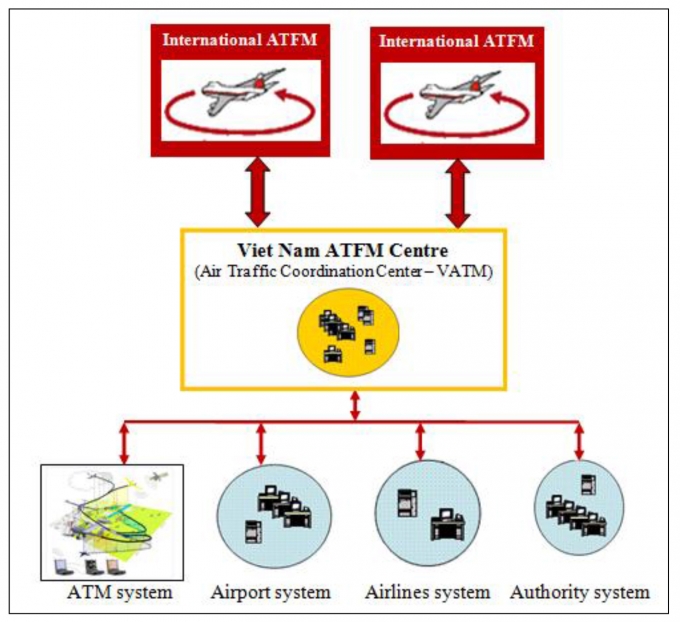Liên hệ quảng cáo
Air traffic flow management solutions for Viet Nam
Air traffic flow management (ATFM) is the science of improving aviation operations by using up-to-date flight information to anticipate future traffic demand, and strategically controlling aggregate flows of flights to keep demand within safe and manageable bounds.
|
M.Sc. Bui Trong Chi Civil Aviation authority of Vietnam Reviewer: Dr. Pham Viet Dung Dr. Bui Van Vo |
Abstract: Air traffic flow management (ATFM) is the science of improving aviation operations by using up-to-date flight information to anticipate future traffic demand, and strategically controlling aggregate flows of flights to keep demand within safe and manageable bounds. Air traffic flow management is an enabler of air traffic management (ATM) efficiency and effectiveness. It contributes to the safety, efficiency, cost effectiveness, and environmental sustainability of air transport industry. International aviation community aims to establish global ATFM. Therefore, the main contents of the article mention the proposed solutions for establishment of ATFM in Viet Nam.
Keywords: Solutions for establishment of Air traffic flow management in Viet Nam.
1. Contents
1.1. The concept of ATFM
1.1.1. Objective of ATFM
Objective of ATFM is designed and implemented in order to enhance the safety of ATM system by ensuring the delivery of safe traffic densities and minimizing traffic surges; optimize flow of air traffic throughout all phases of the operation of a flight by balancing demand and capacity; facilitate collaboration among system stakeholders for optimum operational choices; facilitate the achievement of a seamless and harmonized ATM system while ensuring compatibility with international developments.
1.1.2. Main stakeholders of ATFM
The main stakeholders of ATM system involved in ATFM should be: Air Navigation Service provider; Airspace users/Airlines; Airport operators/Airport ground handler/Airport slot coordinators; Regulators; Military authorities; Security authorities and Meteorological agencies.
1.1.3. Methodology for capacity calculation
1.1.3.1. Airport Acceptance Rate (AAR)
A dynamic parameter specifying the number of arrival aircraft that an airport, in conjunction with terminal airspace, ramp space, parking space, and terminal facilities can accept under specific conditions during any consecutive 60 minute period.
Calculate the optimal AAR can be conducted as follows: Determine the average ground speed crossing the runway threshold and the spacing interval required between successive arrivals. Divide the groundspeed by the spacing interval to determine the optimum AAR. Example: 130 KTS/3,25 nm = 40 Optimum AAR = 40 arrivals per hour.
Identify any conditions that may reduce the optimum AAR: Conditions include intersecting arrival and departure runways; lateral distance between arrival runways; dual use runways - runways that share arrivals and departures; land and hold short operations; availability of high speed taxiways; airspace limitations and constraints; procedural limitations (noise abatement, missed approach procedures); taxiway layouts; meteorological conditions. Determine the adjusted AAR using the previous factors for each runway used in an airport configuration. Add the adjusted AARs for all runways used in an airport configuration to determine the optimal AAR for that runway configuration. Real-time factors may require dynamic adjustments to the optimal AAR. These include: aircraft type and fleet mix on final; runway conditions; runway/taxiway construction; equipment outages; approach control constraints.
POTENTIAL AAR - ADJUSTMENT FACTORS = ACTUAL AAR
1.1.3.2. Sector capacity
Sector capacity is determined using the average sector flight time for any 15 - minute time period. The formula used to determine sector capacity is:
Optimum Sector capacity value = (average flight time in seconds)/(36 seconds).
The time of 36 seconds is a controller’s work time for each flight, which has been defined by human factor study. This is the sector capacity value (optimum). The optimum value for a sector is then adjusted for factors such as: airway structure; airspace volume (vertically and laterally); complexity; climbing and descending traffic; terrain, if applicable; number of adjoining sectors that require interaction and military operations.
1.1.4. Demand and capacity balancing
The main function of ATFM is to balance between capacity and demand. Demand and capacity balancing will be undertaken at the strategic, pre-tactical stages, defined as follows:
- Strategic stage: At the strategic stage, demand and capacity balancing will respond to the fluctuations in schedules and demands, including the increasing globalization of traffic patterns, as well as the seasonal changes of weather and major weather phenomena. This stage will begin as soon as throughput, thus providing a basic for predictable scheduling.
- Pre-tactical stage: At the pre-tactical stage, demand and capacity balancing will evaluate the current allocation of ATM service provider, airspace user and aerodrome operator assets and resources against the projected demands. Through collaborative decision making, when possible, adjustments will be made to assets, resource allocations, projected trajectories, airspace organization and allocation of entry/exit times for aerodrome and airspace volumes to mitigate any imbalance.
- Tactical stage: At the tactical stage, demand and capacity balancing will focus more closely on demand management to adjust imbalances. It will consider weather conditions, infrastructure status, resource allocations and disruptions in schedules that would cause an imbalance to arise. Through collaborative decision making, these actions will include dynamic adjustments to the organization of airspace to balance capacity; dynamic changes to the entry/exit times for aerodromes and airspace volumes and adjustments to the schedules by users.
1.1.5. ATFM organizational structure
Each State can choose an ATFM organizational structure that meets the needs of the aviation community is developed. This structure should address, at a minimum, management and oversight of the following:
- The air traffic flow management service;
- Coordination/exchange of information, both internally and externally;
- A line of authority for the implementation of decisions; and
- Compliance with mission requirements.
A line of authority to support the ATFM service is required. This may include the manager of the ATFM service; the flow management unit (FMU) that provides ATFM service for a specific set of ATS units and flow management positions (FMPs) at specific ATS units responsible for the day-to-day ATFM activities.
Flight Management Unit/Center is the core component of ATFM service, it may be: Local, state or regional.
Bay of Bengal Cooperative Air Traffic Flow Management System (BOBCAT) unit located at AEROTHAI is an example of local ATFM (for one specific Flight Information Region - FIR). BOBCAT is a secure web-based computer system used to manage westbound aircraft operating through Afghanistan airspace from South and Southeast Asia to Europe during the busy nighttime period. BOBCAT assigns take-off times (departure slots) and levels for flights crossing the Kabul FIR based on Aircraft Operator requests.
Air Traffic Flow Management Center of Japan in Fukouka is a state one. This centre uses ATFM tools to apply ATFM measures for flights operating in Japanese FIRs.
Eurocontrol ATFMC providing ATFM service in the airspace of 41 European States plays role of regional centre. This centre manages the capacities of 1750 airspace sectors, 64 enroute centres and 450 airports with over 4,000 connected end-users.
1.2. The need for ATFM implementation in Viet Nam
Currently ATFM service has not actually deployed in Viet Nam, although some specific strategic solutions are being applied by relevant authorities in order to meet the needs of flight operations. Due to the increase of flight operations, geographic location and situation of congestion in some airspace sectors and at Tan Son Nhat airport during peak hours, deploying ATFM service in Viet Nam must be thoughtfully focused.
For the last ten years, the annual average growth of aircraft movement experienced by our ATM system is 9,55% (9,74% for arriving/departing flights and 9,05% for over flights).
 |
At the same period, the aircraft movement at Tan Son Nhat is increased about 2,5 times. Moreover, our Ha Noi and Ho Chi Minh FIRs are located in the middle of South-North and East-West trunk air traffic flows (e.g. A1 is one of the 20 busiest international airways). Therefore, some airspace sectors and airports have become congested during peak hours.
1.3. The proposed ATFM solution
Basing on operational, technical considerations and taking into account the trend of development in the Asia - Pacific Region, the application of ATFM in Viet Nam should initiate with the establishment of only one ATFM centre (state centre) that provides service for both Ha Noi and Ho Chi Minh FIRs.
 |
This center should be developed from the current Air Traffic Coordination Center of Viet Nam Air Traffic Management Corporation. The processing system of this centre (with its ATS database and applications tools) should be connected to ATM system (Radar Data Processing/Flight Data processing) of Ha Noi, Ho Chi Minh ACCs and other systems of airports, airlines and the relevant authorities.
Viet Nam ATFM Center will be coordinated with the other international ATFM center under the multi-nodal ATFM principles in order to offer measures and solutions for the flow of long-haul flights.
 |
2. Conclusion
The authors have focused situational analysis of air traffic management system in Viet Nam and pointed out the urgent requirement of building an Air Traffic Flow Management system. In addition, the authors also proposes the framework of Viet Nam ATFM service, the methodololy for determining airport and airspace sector capacity as a basis for the implementation of ATFM tools. The implementation of ATFM will enhance ANS service quality and improve the capacity of the whole Air Traffic Management of aviation Viet Nam in the context of integration and international alliances.
Reference
[1]. ICAO Doc. 9750 Global Air Navigation Plan.
[2]. ICAO Asia/Pacific seamless ATM Plan.
[3]. ICAO Doc. 4444-RAC/501: Procedures for Air Navigation Services, Rules of the air and air traffic services.
[4]. ICAO Doc. 9971: Manual on Collaborative Air Traffic Flow Management.
[5]. MOT: “Master Plan for development of Communication, Navigation, Surveillance and Air Traffic Management (CNS/ATM) system of 2020 and orientation to 2030”, the Decision No. 2339/QD-BGTVT - (2011).
[6]. MOT: The project to improve safety, capacity and service quality of Vietnam Air Traffic Management Corporation, 2014.
Tag:






Bình luận
Thông báo
Bạn đã gửi thành công.